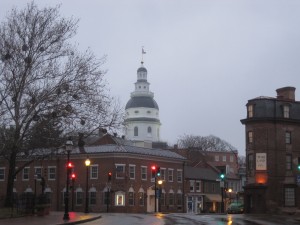Alistair Ford from the Geospatial Engineering group was recently invited to Annapolis, USA for a workshop on “Development of a Prototype of an Integrated Modeling System for Socio-Economic and Environmental Analysis to Promote Sustainability at the Regional Level”. This workshop was hosted by SESYNC, the US National Socio-Environmental Synthesis Center, with a view to setting up a regional modelling framework for use in Maryland and Chesapeake Bay.
Rolf Moekel and Gerrit Knaap from the University of Maryland are working on integrating transport, land-use, climate change, and envirnomental models together in order to understand future changes and pressures in the region. First up, Peter Claggett presented the Chesapeake Bay Land Change Model:
Presentation about CBLCM here.
Brian Gregor from Oregon Department of Transportation then presented his R modelling framework for transport and sustainability modelling called GreenSTEP. This allows the testing of many scenarios of land-use and transport futures to understand the impacts on GHGs. The framework consists of a number of R modules and the resultant scenarios (upwards of 200 in one example!) can be interrogated and explored in a Javascript interface.
Brian Gregor’s presentation is available here.
Another interesting presentation was from Brian Deal of University of Illinois at Urbana-Champaign who talked about his LEAM model. This is a mixed cellular automata and zonal land-use model which run dynamically under uncertainty. It can produce thousands of scenarios and link them to impact models such as flood, water demand, or air quality models.
Brian Deal’s presentation is here.
A number of presentations also talked about data and model integration platforms. Scott Peckham from University of Colorado talked about the EarthCube and CSDMS model integration systems that aim to link together disparate models of similar areas. Tom Bulatewicz from Kansas State University presented the OpenMI model integration platform, and Todd BenDor from University of North Carolina Chapel Hill presented the iRODS database integration plaform which allows the creation of a data grid to collate, curate, update, and link databases.
Scott Peckham’s presentation on CSDMS/EarthCube
The workshop was a very interesting event, with discussions on model complexity, integration, provenance of results, uncertainty, and presentation. The project will be one to watch!

